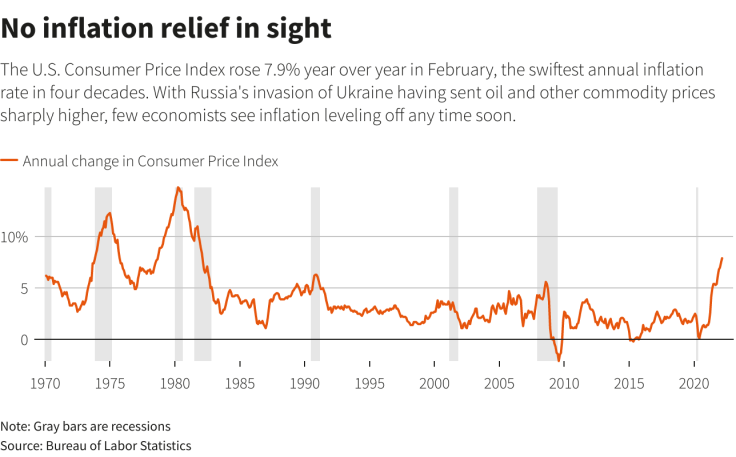Gasoline, Rents Boost U.S. Consumer Prices, More Pain To Come

U.S. consumer prices surged in February, with Americans digging deeper into their wallets to pay for rents, food and gasoline, and inflation is poised to accelerate further in the months ahead as Russia's war against Ukraine drives up the costs of crude oil and other commodities.
The broad rise in prices reported by the Labor Department on Thursday led to the largest annual increase in inflation in 40 years. Inflation was already haunting the economy before Russia's invasion of Ukraine last month, and could further erode President Joe Biden's popularity.
The Federal Reserve is expected to start raising interest rates next Wednesday. With inflation at nearly 4 times the U.S. central bank's 2% target, economists are expecting as many as seven rate hikes this year. Lower income households bear the brunt of high inflation as they spend more of their income on food and gasoline.
"Consumers' shock at rapidly rising gas prices at the pump will continue to put pressure on the Fed and policy makers to do something, anything, to slow down the speed at which prices everywhere are moving higher," said Chris Zaccarelli, chief investment officer at Independent Advisor Alliance in Charlotte, North Carolina.
"There are many people who point out that the Fed can't control supply chains or increase the efficiency of our ports, but they never could. What they can control is interest rates and they are much too low."
Graphic: No inflation relief in sight:

The consumer price index increased 0.8% last month after gaining 0.6% in January. A 6.6% rebound in gasoline prices accounted for almost a third of increase in the CPI. Gasoline prices had declined 0.8% in January. Food prices jumped 1.0%, with the cost of food consumed at home soaring 1.4%.
In the 12 months through February, the CPI shot up 7.9%, the biggest year-on-year increase since January 1982. That followed a 7.5% jump in January and was the fifth straight month of annual CPI readings north of 6%. February's increase in the CPI was in line with economists' expectations.
Last month's CPI data does not fully capture the spike in oil prices following Russia's invasion of Ukraine on Feb. 24. Prices shot up more than 30%, with global benchmark Brent hitting a 2008 high at $139 a barrel, before retreating to trade around $118 a barrel on Thursday.
The United States and its allies have imposed harsh sanctions on Moscow, with Biden on Tuesday banning imports of Russian oil into the country. Russia is the world's second-largest crude oil exporter.
Gasoline prices in the U.S. are averaging a record $4.318 per gallon compared with $3.469 a month ago, AAA data showed.
According to David Kelly, chief global strategist at JPMorgan Funds in New York, if gasoline averaged close to $4.20 for the year, that would add over $1,000 to the expenses of the average household. The Russia-Ukraine war, which has also boosted prices of wheat and other commodities, is seen keeping inflation uncomfortably high into the second quarter.
U.S. stocks opened lower. The dollar rose against a basket of currencies. U.S. Treasury prices fell.
TIGHT LABOR MARKET
Inflation was ignited by a shift in spending to goods from services during the COVID-19 pandemic and trillions of dollars in pandemic relief. The resulting surge in demand ran against capacity constraints as the coronavirus pushed millions of workers out of the labor market, making it harder to move raw materials to factories and finished goods to consumers.
Excluding the volatile food and energy components, the CPI increased 0.5% last month after advancing 0.6% in January. A 0.5% rise in the cost of shelter like rental accommodation as well as hotel and motel accommodation accounted for over 40% of the increase in the so-called core CPI.
Rents jumped 0.6%. Consumers also paid more for recreation, household furnishings and operations, motor vehicle insurance as well as clothing and personal care.
Airline fares soared 5.2% as sharply declining coronavirus infections boosted demand for travel.
In the 12 months through February, the so-called core CPI raced up 6.4%. That was the largest year-on-year gain since August 1982 and followed a 6.0% increase in January.
Before the Russia-Ukraine war, most economists had expected the annual core CPI rate to peak in March just above 6.5% and retreating in April as large increases from last spring started to drop out of the calculation.
"We still think that is the most likely outcome, but there is a risk that energy passthrough effects from the latest spike in oil prices will slow that process," said Lou Crandall, chief economist at Wrightson ICAP in Jersey City.
"Exactly how the Fed will balance the impact of higher oil prices on the inflation data against the 'energy tax' hit to incomes and real spending remains unclear."
Tightening labor market conditions will also contribute to higher inflation, despite monthly wage growth stalling in February. There were a near record 11.3 million job openings at the end of January. The jobs-workers gap was 4.8 million, accounting for 2.9% of the labor force.
A separate report from the Labor Department on Thursday showed initial claims for state unemployment benefits increased 11,000 to a seasonally adjusted 227,000 for the week ended March 5, still at levels consistent with a tight labor market.
Economists had forecast 217,000 applications for the latest week. Claims have dropped from a record high of 6.149 million in early April of 2020.
© Copyright Thomson Reuters {{Year}}. All rights reserved.




















